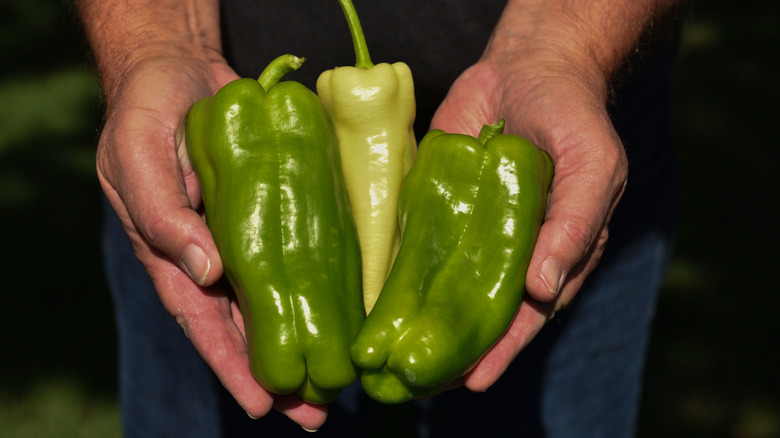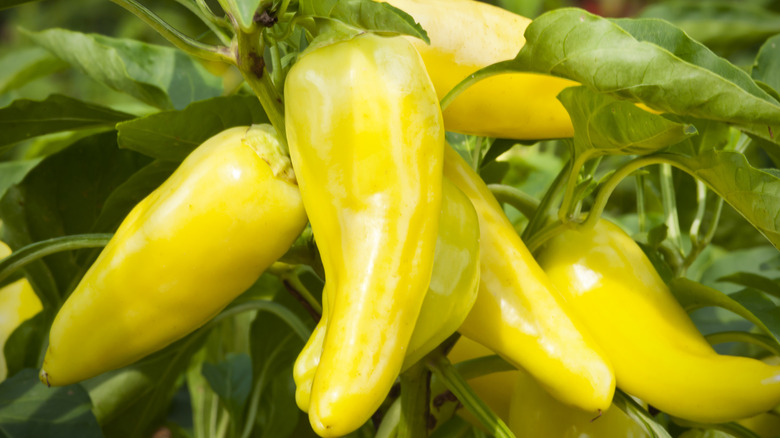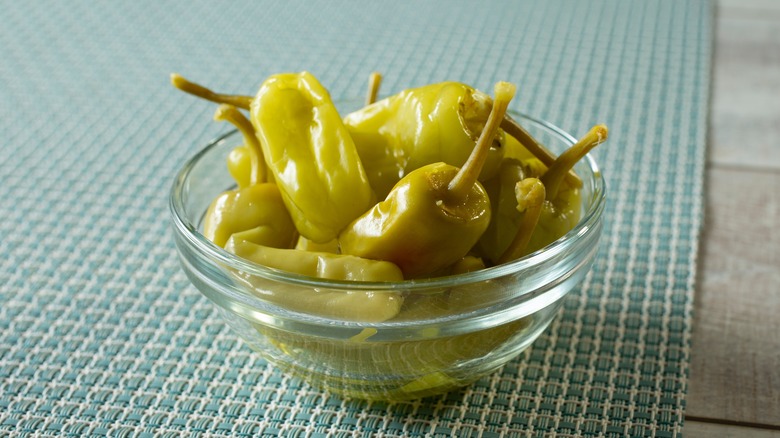Pepperoncini Vs Banana Peppers: How Do They Differ?
Peppers come in a wide range of shapes and sizes — some estimate up to 50,000 different types exist. So it's no surprise that it can be tricky to distinguish between varieties, especially given the fact that many appear so visually similar. Two pepper types that are especially subject to such confusion are banana peppers and pepperoncini.
Although they hail from different origins, the two are quite similar: they're small and yellowish-green, have waxy skin, and offer a mild spice, accompanied by some tangy flavors. Yet despite such similarities, it's worth noting the slight contrasts of the two peppers. In culinary applications, they offer different qualities that set them apart.
Especially for dishes involving pickling or in a roast, you'll want pepperoncini for their more acidic and spicy notes. Meanwhile, the sweeter palate of banana pepper is ideal for stuffing, or as a palatable crunchy addition to a salad. Versing yourself in such slight nuances will help craft the ideal dish.
The two peppers have differences in flavor and appearance
When it comes to the flavor, both peppers max out at 500 on the Scoville scale, so they're not the candidates for increasing your spice tolerance. However, pepperoncini tend to give just a tinge more in heat, since they're never below 100 Scoville units. Additionally, they come with more acidic notes, making them a bolder pepper overall. Conversely, some banana peppers can be completely absent of heat, although certain harvests do get just as hot as banana peppers. To further the milder flavor, they offer some sweet notes, cementing its slightly more gentle nature.
Due to their yellow-green color, the two chilies look similar at first glance. However, note that banana peppers will turn to an orange hue with time, signifying a more concentrated sugar content. It's easier to tell apart the two varieties by their shape; banana peppers grow into a much more elongated form with a slight curve, as evinced by their name. On the other hand, pepperoncini are shorter and rounder. Plus, their skin is more wrinkly, a sharp contrast to the smoothness of banana peppers.
Although similar, the two varieties have specific culinary applications
Generally, either pepper can be employed in a dish, as their flavors are similar enough to fit culinary contexts. Especially since the level of capsaicin in peppers depends on many environmental factors, there's variability among one variety. Nevertheless, many prefer pepperoncini for pickling. Their dependable heat consistently offers a nice bite, meaning they'll meld with the vinegar for the perfect pop. And the measured spice can be carried over to other applications, too — like using pepperoncini juice to upgrade your next dirty martini.
Additionally, the two peppers have some regional affiliations. Pepperoncini are grown in the Mediterranean, lending them alternate names like Golden Greeks and sweet Italian peppers. Accordingly, they frequently feature in Greek salads, atop pizza, or as a pickled addition to an antipasto. They also appear in Southern cooking, as tangy, slightly spicy enhancement to a Mississippi Roast. And they're a fixture topping on the best Italian subs in the U.S.
Meanwhile, banana peppers stem from Hungary, but became popularized in the U.S. They're also a popular candidate for pickling, and a garnish on pizzas. More specifically to the pepper, their uses include being a vessel for stuffing, with the sweet flavor melding well with ingredients like cheese and sausage. And their texture is crunchier, making them a tastier choice for salads. So, you really won't go wrong with either variety, but tailor per dish for the best result.


